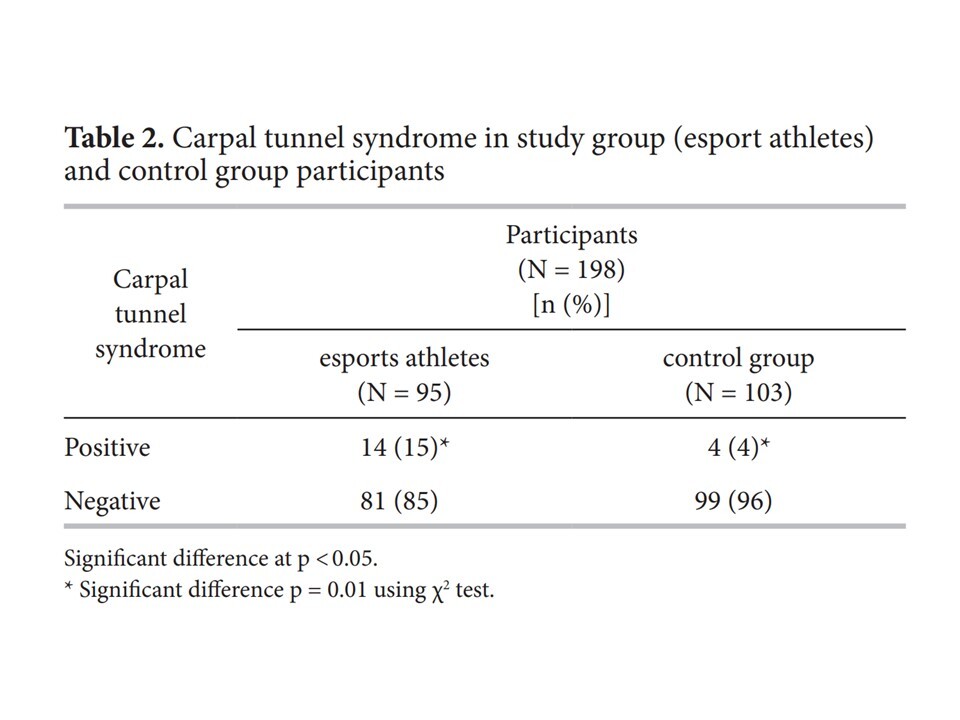Online first
Bieżący numer
Archiwum
Najczęściej cytowane 2024
O czasopiśmie
Zespół Redakcyjny
Komitet Redakcyjny
Polityka prawno-archiwizacyjna
Kup czasopismo
Klauzula informacyjna o przetwarzaniu danych osobowych
Deklaracja dostępności
Instrukcje dla Autorów
Instrukcje dla Recenzentów
Polecamy
Kontakt
Recenzenci
2024
2023
2022
2021
2020
2019
2018
2017
2016
2015
2014
2013
Redakcja i tłumaczenia
PRACA ORYGINALNA
The impact of electronic gaming on upper-limb neuropathies among esports athletes
1
Princess Nourah bint Abdulrahman University, Riyadh, Kingdom of Saudi Arabia (Department of Rehabilitation Sciences, College of Health and Rehabilitation Sciences)
2
King Saud University, Riyadh, Kingdom of Saudi Arabia (Neurology Unit, Department of Internal Medicine, College of Medicine)
Data publikacji online: 24-10-2023
Autor do korespondencji
Reem M. Basuodan
Princess Nourah bint Abdulrahman University, Department of Rehabilitation Sciences, College of Health and Rehabilitation Sciences, P.O. Box 84428, Riyadh, Kingdom of Saudi Arabia 11671
Princess Nourah bint Abdulrahman University, Department of Rehabilitation Sciences, College of Health and Rehabilitation Sciences, P.O. Box 84428, Riyadh, Kingdom of Saudi Arabia 11671
Med Pr Work Health Saf. 2023;74(4):279-87
SŁOWA KLUCZOWE
DZIEDZINY
STRESZCZENIE
Background: The authors aimed to explore carpal tunnel syndrome (CTS) among electronic sports (esports) athletes, to compare hand symptoms and their severity between esports athletes and the control group and within the esports athletes, and to study the relationship between esports athletes’ variables. Material and Methods: A cross-sectional survey study via telephone with systematic randomized approach was used for esport athletes sampling. Control group were non-esports athletes who do not use computer for prolonged duration. The survey consisted of sports athletes’ characteristics, hand symptoms and functions, and the Boston Carpal Tunnel Questionnaire (BCTQ). The unpaired student’s t-test, Mann-Whitney U test, and χ2 test were utilised for statistical comparison, with p < 0.05. Pearson’s and Spearman’s correlation coefficient tests were used for relationship analyses. Results: Eligible participants were 198 out of 229. Compared to control group, esport athletes reported more CTS (p = 0.01), and radiated pain and numbness in their hands (p = 0.05). Males complained of hand symptoms (p < 0.01) and its radiation (p < 0.01) more than females among esports athletes. Higher BCTQ Symptom Severity Scale (BCTQ-SSS) scores were reported for esports athletes who had been playing esports for prolonged periods compared to those who had playing recently (p = 0.003), with a moderate positive correlation (+0.59, p = 0.004). A significant moderate positive correlation was reported for BCTQ Functional Severity Symptoms (BCTQ-FSS) scores in terms of hours of playing (+0.44, p = 0.04). Esports athletes who used armrests and a PC with a controller for gaming reported less hand symptoms and had milder BCTQ scores than those who used a PC with a keyboard/mouse. Generally, esports athletes spend 5–10 h/day on gaming. Conclusions: Esports athletes might be at risk of developing upper-extremity nerve compression and CTS. Prolonged playing, hours of playing, type of esports device, and using armrests are possible risk factors. Med Pr Work Health Saf. 2023;74(4):279–87.
Udostępnij
ARTYKUŁ POWIĄZANY
Przetwarzamy dane osobowe zbierane podczas odwiedzania serwisu. Realizacja funkcji pozyskiwania informacji o użytkownikach i ich zachowaniu odbywa się poprzez dobrowolnie wprowadzone w formularzach informacje oraz zapisywanie w urządzeniach końcowych plików cookies (tzw. ciasteczka). Dane, w tym pliki cookies, wykorzystywane są w celu realizacji usług, zapewnienia wygodnego korzystania ze strony oraz w celu monitorowania ruchu zgodnie z Polityką prywatności. Dane są także zbierane i przetwarzane przez narzędzie Google Analytics (więcej).
Możesz zmienić ustawienia cookies w swojej przeglądarce. Ograniczenie stosowania plików cookies w konfiguracji przeglądarki może wpłynąć na niektóre funkcjonalności dostępne na stronie.
Możesz zmienić ustawienia cookies w swojej przeglądarce. Ograniczenie stosowania plików cookies w konfiguracji przeglądarki może wpłynąć na niektóre funkcjonalności dostępne na stronie.






